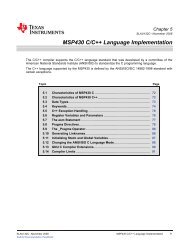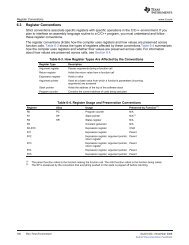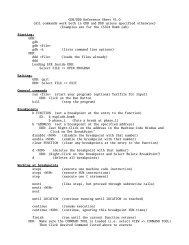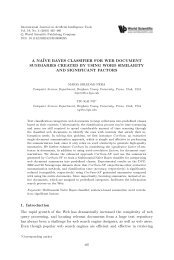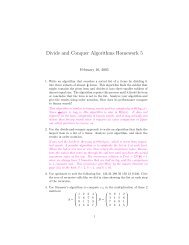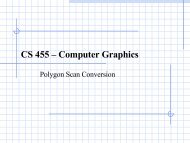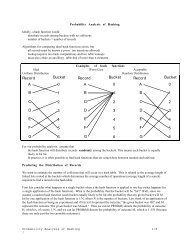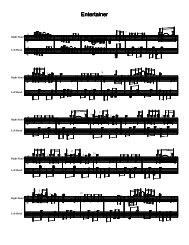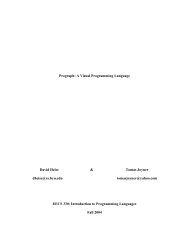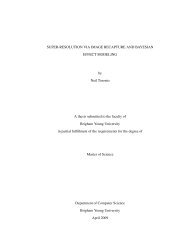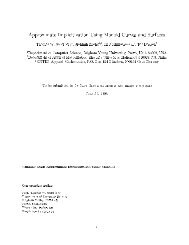White Box Testing
White Box Testing
White Box Testing
- No tags were found...
You also want an ePaper? Increase the reach of your titles
YUMPU automatically turns print PDFs into web optimized ePapers that Google loves.
<strong>White</strong> <strong>Box</strong> <strong>Testing</strong>Sources:Code Complete, 2 nd Ed., Steve McConnellSoftware Engineering, 5 th Ed., Roger Pressman
<strong>White</strong> <strong>Box</strong> <strong>Testing</strong>• <strong>White</strong> box testing is primarily used during unit testing• Unit testing is usually performed by the engineer who wrote the code• In some cases an independent tester might do unit testing
Complete Path Coverage• Test ALL possible paths through a subroutine• Example What test cases are needed to achieve complete pathcoverage of this subroutine?• Some paths may be impossible to achieve. Skip those paths • Often there are too many paths to test them all, especially if there areloops in the code. In this case, we use less complete approaches:– Line coverage– Branch coverage– Condition testing– Loop testing
Line coverage• At a minimum, every line of code should be executed by at least onetest case• Example What test cases are needed to achieve complete line coverageof this subroutine?• Developers tend to significantly overestimate the level of line coverageachieved by their tests• Coverage tools (like Cobertura) are important for getting a realisticsense of how completely your tests cover the code• Complete line coverage is necessary, but not sufficient
Branch coverage• Similar to line coverage, but stronger• Test every branch in all possible directions• If statements– test both positive and negative directions• Switch statements– test every branch– If no default case, test a value that doesn't match any case• Loop statements– test for both 0 and > 0 iterations
Branch coverage• Example What test cases are needed to achieve complete branchcoverage of this subroutine?• Why isn't branch coverage the same thing as line coverage?
Branch coverage• Example What test cases are needed to achieve complete branchcoverage of this subroutine?• Why isn't branch coverage the same thing as code coverage?– Consider an if with no else, or a switch with no default case– Line coverage can be achieved without achieving branch coverage
Complete Condition testing• For each compound condition, C• Find the simple sub-expressions that make up C– Simple pieces with no ANDs or ORs– Suppose there are n of them• Create a test case for all 2 n T/F combinations of the simple subexpressions– If (!done && (value < 100 || c == 'X')) …– Simple sub-expressions• !done, value < 100, c == 'X'• n = 3• Need 8 test cases to test all possibilities
Partial Condition testing• This is similar to what Cobertura calls branch coverage, except thatthey only consider the True and False cases of simple sub-expressions• The test cases for a particular sub-expression must actually executethat sub-expression– If (!done && (value < 100 || c == 'X')) …– Think about short-circuiting– Above, if done is T, the rest of the expression doesn't matteranyway– The test cases for value < 100 would need to set done to F– The test cases for c == 'X' would need to set done to F and value>= 100
Compute Net PaytotalWithholdings = 0;What test cases do we need to achievefor ( id = 0; id < numEmployees; ++id) {// compute social security withholding, if below the maximumif ( m_employee[ id ].governmentRetirementWithheld < MAX_GOVT_RETIREMENT) {governmentRetirement = ComputeGovernmentRetirement( m_employee[ id ] );}// set default to no retirement contributioncompanyRetirement = 0;// determine discretionary employee retirement contributionif ( m_employee[ id ].WantsRetirement && EligibleForRetirement( m_employee[ id ] ) ) {companyRetirement = GetRetirement( m_employee[ id ] );}grossPay = ComputeGrossPay( m_employee[ id ] );Line coverage?Branch coverage?Complete condition testing?Partial condition testing?// determine IRA contributionpersonalRetirement = 0;if (EligibleForPersonalRetirement( m_employee[ id ] ) {personalRetirement = PersonalRetirementContribution( m_employee[ id ], companyRetirement, grossPay );}// make weekly paycheckwithholding = ComputeWithholding( m_employee[ id ] );netPay = grossPay - withholding - companyRetirement - governmentRetirement - personalRetirement;PayEmployee( m_employee[ id ], netPay );}// add this employee's paycheck to total for accountingtotalWithholdings += withholding;totalGovernmentRetirement += governmentRetirement;totalRetirement += companyRetirement;SavePayRecords( totalWithholdings, totalGovernmentRetirement, totalRetirement );
Loop <strong>Testing</strong>• Design test cases based on looping structure of the routine• <strong>Testing</strong> loops– Skip loop entirely– One pass– Two passes– N-1, N, and N+1 passes [N is the maximum number of passes]– M passes, where 2 < M < N-1
Loop <strong>Testing</strong>int ReadLine(istream & is, char buf[], int bufLen) {int count = 0;while (count < bufLen) {int c = is.get();if (c != -1 && c != '\n')buf[count++] = (char)c;}elsebreak;}return count;What test cases do we need?1) Skip loop entirely:a. bufLen == 02) Exactly one pass:a. line of length 1 (including the '\n') OR bufLen == 13) Exactly two passes:a. line of length 2 OR bufLen == 24) N-1, N, and N+1 passes:a. lines of length bufLen-1, bufLen, and bufLen+15) M passes, where 2 < M < N-1a. line of length bufLen / 2
Data Flow <strong>Testing</strong>• The techniques discussed so far have all been based on "control flow"• You can also design test cases based on "data flow“ (i.e., how data flowsthrough the code)• Some statements "define" a variable’s value (i.e., a “variable definition”)– Variable declarations with initial values– Assignments– Incoming parameter values• Some statements "use" variable’s value (i.e., a “variable use”)– Expressions on right side of assignment– Boolean condition expressions– Parameter expressions
Data Flow <strong>Testing</strong>• For every "use" of a variable– Determine all possible places in the program where the variablecould have been defined (i.e., given its most recent value)– Create a test case for each possible (Definition, Use) pair
Data Flow <strong>Testing</strong>If ( Condition 1 ) {x = a;}Else {x = b;}If ( Condition 2 ) {y = x + 1;}Else {y = x – 1;}What test cases do we need?Definitions: 1) x = a; 2) x = b;Uses: 1) y = x + 1; 2) y = x – 1;1. (x = a, y = x + 1)2. (x = b, y = x + 1)3. (x = a, y = x – 1)4. (x = b, y = x – 1)
Data Flow <strong>Testing</strong>• Example Use data flow testing to design a set of test cases for thissubroutine.
Relational condition testing• <strong>Testing</strong> relational sub-expressions• (E1 op E2)• ==, !=, =• Three test cases to try:– Test E1 == E2– Test E1 slightly bigger than E2– Test E1 slightly smaller than E2
const int CHUNK_SIZE = 100;Internal Boundary <strong>Testing</strong>char * ReadLine(istream & is) {int c = is.get();if (c == -1) {return 0;}char * buf = new char[CHUNK_SIZE];int bufSize = CHUNK_SIZE;int strSize = 0;while (c != '\n' && c != -1) {if (strSize == bufSize - 1) {buf = Grow(buf, bufSize);bufSize += CHUNK_SIZE;}buf[strSize++] = (char)c;What test cases do we need?Lines of length 99, 100, 101}c = is.get();buf[strSize] = '\0';}return buf;
Data Type Errors• Scan the code for data type-related errors such as:– Arithmetic overflow• If two numbers are multiplied together, what happens if they'reboth large positive values? Large negative values?• Is divide-by-zero possible?– Other kinds of overflow• If two strings are concatenated together, what happens ifthey're both unusually long– Casting a larger numeric data type to a smaller one• short s = (short)x; // x is an int– Combined signed/unsigned arithmetic
Built-in Assumptions• Scan the code for built-in assumptions that may be incorrect– Year begins with 19– Age is less than 100– String is non-empty– Protocol in URL is all lower-case• What about "hTtP://..." or FTP://...?
Limitations of white box testing• Whatever blind spots you had when writing the code will carry over into your white boxtesting– <strong>Testing</strong> by independent test group is also necessary• Developers often test with the intent to prove that the code works rather than provingthat it doesn't work• Developers tend to skip the more sophisticated types of white box tests (e.g., conditiontesting, data flow testing, loop testing, etc.), relying mostly on line coverage• <strong>White</strong> box testing focuses on testing the code that's there. If something is missing (e.g.,you forgot to handle a particular case), white box testing might not help you.• There are many kinds of errors that white box testing won't find– Timing and concurrency bugs– Performance problems– Usability problems– Etc.




